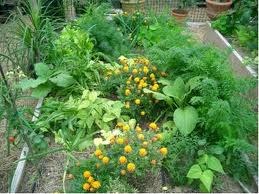Welcome to the world of companion planting! Companion planting is the practice of planting two or more plant species close together to gain benefits either on growth, flavor or pest control.

Did you know that petunias repel asparagus beetles? And that marigolds planted among potatoes discourage Colorado potato beetles? I have also heard that cabbage planted near lettuce has an adverse effect on the growth and flavor of the lettuce - so there are some plants that may have a bad effect on their neighbors!
One of the oldest examples of companion gardening is often referred to as the Native American "Three Sisters Garden". The "Three Sisters" are corn, beans and pumpkin or squash planted together in groups or hills. Native American myths speak of Three Sisters who could not get along, but are convinced to use their differences to help each other - so much so that they depend upon each other. Meals resulting from a Three Sisters garden - corn and squash for energy and beans for protein - provide delicious and nutritious dining.
How does each "Sister" benefit the others?
Nitrogen fixing legumes like beans are able to have a relationship with bacteria in soil, Rhizobium, that benefits both bacteria and bean. These bacteria form nodules on the Bean Sisters' roots. They are then able to take in atmospheric nitrogen - usually unavailable to plants - and convert it to a form that plants can use. This is good for the bacteria, the bean, squash and, especially, corn! Corn requires A LOT of nitrogen to grow well and benefits greatly from the nitrogen-fixing beans.
What does Sister Corn contribute? Pole beans are able to climb the corn stalks. Also, the high canopy of corn foliage may confuse the adult squash borer and reduce the damage of this pest on the squash.
Finally, how does Sister Squash bless her two siblings? The broad spreading leaves of the squash vines provide living mulch for the corn and beans, to reduce weeds and hold moisture. Also, prickly squash vines climbing corn stalks may deter raccoon invasion of the corn.
Other benefits of companion planting
There are several other important ways that companion plants help each other as a result of their close proximity.
Trap cropping is the practice of planting something between the main crop that attracts a specific pest away from it. An example is planting dill among tomatoes. Tomato horn worms prefer the dill. Nasturtiums attract aphids and many other pests.
Marigolds planted among vegetable garden rows benefit their edible neighbors through biochemical pest suppression. Marigolds produce thiopene which deters harmful nematodes in the soil.
Many companion plants provide attractive environments for beneficial insects such as pollinators and predator species (lady beetles and lacewings) that help reduce pest populations. Plants in the Umbel family (carrots, parsley, dill) are known for this, as is sweet alyssum.
Are you interested? There are thousands of combinations of companion plants recommended so it can be overwhelming. Start slowly! Surf the web! Keep a diary! Try targeting two or three of your most serious pests - for me it would be Asparagus Beetles and Colorado Potato Beetle. Try combinations of your favorites that will benefit each other. We are in this together! Feel free to contact Penn State Master Gardeners with your questions and comments. Master Gardeners are in the Extension office every Tuesday and Friday from 10:00 -12:00 noon or you can email your questions to them at: mggardeners@yahoo.com or call at 278-1158.
Enjoy the journey!
By Dorrie Mininger, Penn State Master Gardener

